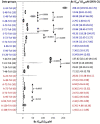In vitro susceptibility of Trypanosoma cruzi discrete typing units (DTUs) to benznidazole: A systematic review and meta-analysis
- PMID: 33750958
- PMCID: PMC8016252
- DOI: 10.1371/journal.pntd.0009269
In vitro susceptibility of Trypanosoma cruzi discrete typing units (DTUs) to benznidazole: A systematic review and meta-analysis
Abstract
Background: Chagas disease, a neglected tropical disease endemic to Latin America caused by the parasite Trypanosoma cruzi, currently affects 6-7 million people and is responsible for 12,500 deaths each year. No vaccine exists at present and the only two drugs currently approved for the treatment (benznidazole and nifurtimox), possess serious limitations, including long treatment regimes, undesirable side effects, and frequent clinical failures. A link between parasite genetic variability and drug sensibility/efficacy has been suggested, but remains unclear. Therefore, we investigated associations between T. cruzi genetic variability and in vitro benznidazole susceptibility via a systematic article review and meta-analysis.
Methodology/principal findings: In vitro normalized benznidazole susceptibility indices (LC50 and IC50) for epimastigote, trypomastigote and amastigote stages of different T. cruzi strains were recorded from articles in the scientific literature. A total of 60 articles, which include 189 assays, met the selection criteria for the meta-analysis. Mean values for each discrete typing unit (DTU) were estimated using the meta and metaphor packages through R software, and presented in a rainforest plot. Subsequently, a meta-regression analysis was performed to determine differences between estimated mean values by DTU/parasite stage/drug incubation times. For each parasite stage, some DTU mean values were significantly different, e.g. at 24h of drug incubation, a lower sensitivity to benznidazole of TcI vs. TcII trypomastigotes was noteworthy. Nevertheless, funnel plots detected high heterogeneity of the data within each DTU and even for a single strain.
Conclusions/significance: Several limitations of the study prevent assigning DTUs to different in vitro benznidazole sensitivity groups; however, ignoring the parasite's genetic variability during drug development and evaluation would not be advisable. Our findings highlight the need for establishment of uniform experimental conditions as well as a screening of different DTUs during the optimization of new drug candidates for Chagas disease treatment.
Conflict of interest statement
I have read the journal’s policy and the authors of this manuscript have the following competing interests:Marco Coral-Almeida is deputy editor of PLOS NTDS.
Figures


References
-
- World Health organization. Chagas disease (also known as American trypanosomiasis). Fact Sheets. 2020 updated updated March 2020]. Available from: https://www.who.int/en/news-room/fact-sheets/detail/chagas-disease-(amer.... 10.1590/0037-8682-0081-2015 - DOI - PubMed
-
- Rassi A, Marcondes de Rezende J, Luquetti AO, Rassi JA. Clinical phases and forms of Chagas Disease. In: Telleria J, Tibayrenc M, editors. American Trypanosomiasis Chagas Disease One Hundred Years of Research. Washington D.C.: Elsevier; 2010. p. 709–41.
-
- Pinto Dias JC, Schofield CJ. Social and Medical Aspects: Morbidity and Mortality in General Population. In: Telleria J, Tibayrenc M, editors. American Trypanosomiasis Chagas Disease One Hundred Years of Research Washington D.C.: Elsevier; 2010. p. 45–54.
Publication types
MeSH terms
Substances
LinkOut - more resources
Full Text Sources
Other Literature Sources
Miscellaneous

